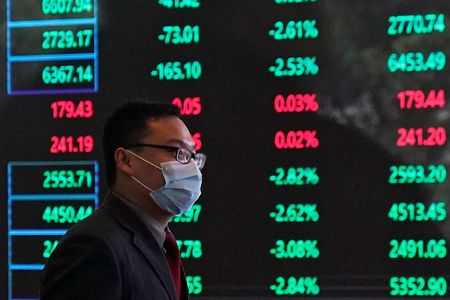By Mike Dolan
LONDON (Reuters) – Yet another eye-catching rebound in global stocks may just be another bear market bounce – but investors do sense the end of a dark road, even if there’s still some distance to go.
The dominant theme of the past week has been how Britain’s bizarre fiscal splurge and reversal over just one month marks the limit of how much borrowing governments can amass in an inflationary environment. Taken at face value, it now seems clear this merely forces a more brutal monetary squeeze and sends bond creditors running scared.
If that cautionary tale is absorbed by other economies, then some of the more extreme concerns about how high interest rates may need to go in this cycle may now be scaled back – especially if much-reduced fiscal room deepens oncoming recessions.
On returning from the annual International Monetary Fund meetings last week, Goldman Sachs strategist Kamakshya Trivedi said Britain’s shock “sucked a lot of air” from the gathering and one focus was on whether the British experience would “constrain other jurisdictions with limited fiscal space.”
Societe Generale’s contrarian strategist Albert Edwards said Britain’s reawakening of the fabled ‘bond vigilantes’ would “reverberate around financial markets for years to come.”
For others hyper-focussed on ebbing central bank liquidity as the main reason for this year’s plunge in world asset prices, signs of extreme bond market stress and dysfunction in a G4 economy was a warning shot across the bow of central bank plans to run down COVID-19 pandemic-bloated balance sheets in earnest.
Reports this week, later quashed, that the Bank of England will again postpone its ‘quantitative tightening’ (QT) of active bond sales due next month merely fired up speculation about just how far that liquidity withdrawal can progress before something breaks – much like the Federal Reserve’s last QT spell in 2018.
And many read across to ebbing liquidity in U.S. Treasury markets for a take on Fed parameters this time around too.
Liquidity specialists CrossBorder Capital think policymakers will want to avoid the potential ‘doom loop’ between debt accumulation, rising rates and long-term fiscal pressures. “This means that quantitative easing will return, although most likely in the altered guise of (Japan-style) yield curve control.”
Of course, yearend stress in fractious, inflation-wracked bond and currency markets is hardly an ideal backdrop for prolonged market rallies – not least when there are few signs central banks are done with jumbo interest rate hikes, never mind being close to peak rates.
And looser financial conditions at this stage may even goad policymakers into stamping harder to ensure inflation is licked – as they did this summer.
Even though evaporating year-on-year oil prices gains and mounting global recession forecasts may be seen as positive twists on that inflation horizon, the geopolitical forces still dictating much of that outcome are hardly any clearer.
(Bank of America chart on fund survey of cash holdings https://fingfx.thomsonreuters.com/gfx/mkt/egvbkzrzbpq/One.PNG)
(S&P 500’s failed rallies https://graphics.reuters.com/USA-STOCKS/BOTTOM/jnpweqmqwpw/Screenshot%202022-10-18%20at%2018.11.53.png)
‘PEAK FEAR’?
So, are these bounces clever second-guessing or just wishful thinking?
There are other sparks beyond policy hitting the buffers and multiple short-term factors have been blamed for the 6-7% trough-to-peak bounce in world stocks over the past week – the third such rally in just six weeks.
Chart patterns and favourable seasonal flows in the middle of October are among some of the reasons cited.
But extreme portfolio positioning is the most compelling.
Other investors returning from last week’s IMF meeting were slightly overwhelmed by the sheer gloom in Washington and were inclined to look beyond it.
“The contrarian in me came away from the meetings thinking that the consensus may now have become too bearish and that we may be at or close to ‘peak fear’ in the markets,” said Pimco economic adviser Joachim Fels.
Bank of America’s October survey of global fund managers, released on Tuesday, certainly backs that up.
The survey showed funds raised cash levels further this month to the highest in 21 years – and ‘screams macro capitulation, investor capitulation, (and the) start of policy capitulation’, according to BofA analysts who compiled the poll, adding portfolio positioning stayed close to ‘max bearishness’.
Amid the detailed findings, four things stood out.
First was that global funds aggregate underweight in equities was now a full three standard deviations from the mean positioning of past 10 years.
Second was a near record net 72% of funds expect a weaker economy in the next 12 months – stark even as high-frequency economic surprise indices continue to come in positive.
Third was the shift in views on rates and yields, with more than a halving over the month to a net 30% expecting higher short-term rates over the next 12 months while the 38% expecting lower long-term bond yields almost matched the 41% expecting them higher.
And finally, respondents expected financial stability risks at their highest in the history of survey – even greater than levels seen at the height of the pandemic or during the 2007/2008 crash.
There’s a lot of angst packed in there – but also a lot baked in to portfolios to match it.
On the other hand, overstretched positions can last longer than you think in uncertain environments. The BoA survey has ‘long US dollar’ as the ‘most crowded trade’ for the fourth month in a row this month – and each month it gets more crowded.
(VIX and bear markets https://fingfx.thomsonreuters.com/gfx/mkt/klvykxawlvg/Pasted%20image%201666105195465.png)
(S&P 500’s forward PE dips below 10-year average https://fingfx.thomsonreuters.com/gfx/mkt/zgvomqokzvd/Pasted%20image%201666034489093.png)
The opinions expressed here are those of the author, a columnist for Reuters.
(by Mike Dolan, Twitter: @reutersMikeD. Charts by Bank of America, Vincent Flasseur and Lewis Krauskopf; Editing by Josie Kao)

